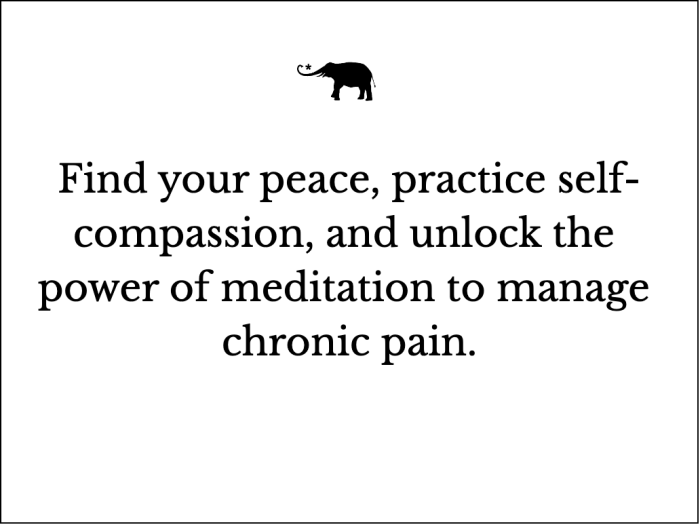Chronic pain affects physical health and mental well-being. Traditional medical treatments can help alleviate many of these issues. Many people turn to meditation as a non-invasive, drug-free way to manage chronic pain.
But meditation for chronic pain has unique challenges. For one, sitting for an extended period can be painful and unattainable for many with chronic pain. However, research supports different types of meditation and mindfulness that may provide benefits without the risk of increased pain.
Whether you’re dealing with backaches or migraines, there are various ways to incorporate meditation into your daily regimen. Let’s explore multiple approaches to meditating for chronic pain relief – from guided audio programs to advanced yogic practices – along with tips on how to make the most out of your mindfulness routine.
What is meditation?
Meditation is an ancient practice that balances the mind and body. By focusing on breath, posture, movement, or an object of attention, people can recognize the thoughts and sensations they experience without identifying with them. This helps create a sense of mental and physical relaxation in the body, which can help relieve stress.
Mindfulness is a practice that emphasizes awareness of the present moment. Mindfulness involves noticing sensations, thoughts, and emotions without judgment or attachment. It is an effective way to reduce stress by helping people to step back and observe their inner experiences objectively.
Meditation practice allows for mindfulness space. Practicing meditation regularly will enable us to focus on the present moment more easily.
The benefits of meditation
Research suggests a variety of ways that mediation can lead to improvements in physical and mental health.
Stress Reduction
Regular meditation can help reduce stress levels, which may improve overall health.
Improved concentration
Research on meditation has been found to improve focus, concentration, and executive function. The ability to focus for long periods can be beneficial.
Pain reduction
Mindfulness practices such as breath awareness or body scans are effective in helping people cope with chronic pain.
Different types of meditation
Meditation comes in many different shapes and forms. However, the constant factor is the ability to focus on one task: breath, movement, mantra, or path.
People suffering from chronic pain often have difficulty sitting, standing, or lying down for long periods. For example, individuals who experience chronic low back pain may find sitting challenging for an extended period. Walking meditations may be a better fit in this case.
Those with fibromyalgia, rheumatoid arthritis, Lyme Disease, or other systemic inflammatory disorders may do best with movement-based meditation such as Tai Chi or Qi Gong.
There is also a connection between chronic physical pain and emotional pain. Research indicates that emotional and physical pain are linked, although specific mechanisms are still being studied. Therefore, it is essential to recognize any negative experiences with meditation for pain relief and seek appropriate medical care through your physician or therapist.
- Mindfulness meditation
Mindfulness meditation focuses on becoming aware and accepting the present moment without judgment or attachment. It is often practiced with the eyes closed and focuses on your breath or bodily sensations.
- Guided meditation
Guided meditation is often done with the guidance of an audio or video program. It involves allowing your mind to focus on visualizations and mantras while guided by the instructor.
- Movement meditation
Movement-based meditation involves using your body to create a meditative practice such as yoga, qigong, tai chi, or walking meditation. This can be a great way to meditate without any physical stress on specific body areas. Additionally, gentle exercise is also recommended for managing chronic pain.
- Mantra meditation
Mantra meditation involves repeating a phrase or sound, either aloud or silently, to help bring focus and clarity to mind.
- Visualization meditation
Visualization meditation involves focusing on an image to bring clarity and focus to the mind. It can help cultivate positive emotions, reduce stress, and create feelings of relaxation.
No matter what type of meditation you choose, it is essential to remember that the benefits of meditation come from consistency and practice. So make sure to take your time and find a method that works for you.
The importance of self-compassion with chronic pain
It is also essential to recognize the importance of self-compassion in chronic pain. Self-compassion can be a powerful tool in managing chronic pain and promoting overall well-being. Self-compassion involves treating yourself with kindness, understanding, forgiving mistakes, and recognizing common humanity.
There is no right or wrong way to practice meditation, only the best way for you. This may take some exploration, but it can be worth the journey. When managing chronic pain, it is helpful to have many tools in the toolbox – medications, therapists, body work, exercise, and nutrition. Meditation is one tool that may help manage chronic pain.
Be gentle and kind with yourself on this journey. Meditation can be an effective tool for managing chronic pain. By exploring different types of meditation, we can find the one that works best for us.

 Share on bsky
Share on bsky





Read 3 comments and reply